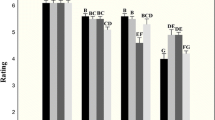Abstract
A bacterial strain, CFBP 3388, isolated from Vetch (Vicia sativa, L.) was identified asP. s. pv.syringae on the basis of nutritional and biochemical patterns which were obtained with classical tests and the Biolog™ system. It caused necrotic symptoms typical ofP. s. pv.syringae on bean leaves and pods after artificial inoculation. However, the isolate caused a citrulline-reversible inhibition ofE. coli in phaseolotoxin bioassay. Furthermore, with CFBP 3388 DNA as template a 1900 bp DNA fragment, specific for the phaseolotoxin DNA cluster ofP. s. pv.phaseolicola, was amplified by PCR. This is the first demonstration that an isolate ofP. syringae that is not pv.phaseolicola can produce phaseolotoxin
Similar content being viewed by others
Abbreviations
- bp:
-
base pair
- kb:
-
kilobase
- OCT:
-
Ornithine Carbamoyl Transferase
References
Ayers SH, Rupp P and Johnson WT (1919) A study of alkali forming bacteria found in milk. Bulletin of the U.S. Department of Agriculture 782
Dye DW (1962) The inadequacy of the usual determinative tests for the identification ofXanthomonas spp. N. Z. J. Sci. 5 4: 393–416
Ferguson AR and Johnson JS (1980) Phaseolotoxin: chlorosis, ornithine accumulation and inhibition of ornihine carbamoyltransferase from different plants. Physiol. Plant Pathol. 16: 269–275
Hanahan D (1983) Studies on transformation ofEscherichia coli with plasmids. Journal of Molecular Biology 166: 557–580
Jansing H and Rudolph K (1990) A sensitive and quick test for determination of bean seed infestation byPseudomonas syringae pv.phaseolicola. Journal of Plant Diseases and Protection 97: 42–55
King EO, Ward MK, and Raney DE (1954) Two simple media for the demonstration of pyocyanin and fluorescein. Journal of Laboratory and Clinical Medicine 44: 301–307
Klement Z and Lovrekovich L (1961) Defence reactions induced by phythopathogenic bacteria in bean pods. Phytopathologisches Zeitschrift 3: 217–227
Lelliott RA, Billing E, and Hayward AC (1966) A determinative scheme for the fluorescent plant pathogenic pseudomonads. Journal of Applied Bacteriology 29: 470–489
Manceau C and Tourte C (1991) Détection directe dePseudomonas syringae pathovarphaseolicola par amplification génique en chaîne (PCR). Phytoma-La Défense des Végétaux 430: 36
Maniatis T, Fritsch EF and Sambrook J (1982) Molecular cloning: a laboratory manual. Cold Spring Harbor Laboratory Press, New York
Mitchell RE (1976) Bean halo-blight toxin. Nature 260: 75–76
Mohan SK and Schaad NW (1987) An improved agar plating assay for detectingPseudomonas syringae pv.syringae andP. s. pv.phaseolicola in contaminated bean seed. Phytopathology 77: 1390–1395
Patil SS, Kolattukudy PE and Diamond AE (1970) Inhibition of carbamoyltransferase from bean plants by the toxin ofPseudomonas phaseolicola. Plant Physiology 46: 752–753
Patil SS, Tam LQ and Sakai WS (1972) Mode of action of the toxin fromPseudomonas phaseolicola. I. Toxin specificity, chlorosis and ornithine accumulation. Plant Physiology 49: 803–807
Peet RC, Lindgren PB, Willis DK, and Panopoulos NJ (1986) Identification and cloning of genes involved in phaseolotoxin production byPseudomonas syringae pv.phaseolicola. Journal of Bacteriology 166: 1096–1105
Peet RC and Panopoulos NJ (1987) Ornithine carbamoyltransferase genes and phaseolotoxin immunity inPseudomonas syringae pv.phaseolicola. The EMBO Journal 6: 3585–3591
Prosen D, Hatziloukas E, Schaad NW and Panopoulos NJ (1993). Specific detection ofPseudomonas syringae pv.phaseolicola DNA in bean seed by polymerase chain reaction-based amplification of a phaseolotoxin gene region. Phytopathology 83: 965–970
Rudolph K (1974) Non-specific toxins. In: Heitefuss R and Williams PH (eds) Physiological Plant Pathology (pp 270–315) Springer-Verlag, Berlin
Rudolph K and Stahmann MA (1966) The accumulation of L-ornithine in halo-blight infected plants (Phaseolus vulgaris L.) induced by the toxin of the pathogenPseudomonas phaseolicola (Burkh.). Phytopathology 57: 29–46
Schaad NW, Azad H, Peet RC and Panopoulos NJ (1989) Identification ofPseudomonas syringae pv.phaseolicola by a DNA hybridization probe. Phytopathology 79: 903–907
Schroth MN, Vitanza VB and Hildebrand DC (1971) Pathogenic and nutritional variation in the halo blight group of fluorescent pseudomonads of bean. Phytopathology 67: 852–857
Staskawicz BJ and Panopoulos NJ (1979) A rapid and sensitive microbiological assay for phaseolotoxin. Phytopathology 69: 663–666
Tourte C and Manceau C (1991) Construction et utilisation de sondes froides pour l'identification dePseudomonas syringae pathovarphaseolicola, agent de la graisse à halo du haricot. Phytoma-La Défense des Végétaux 430: 40
Turner JG and Mitchell RE (1985) Association between symptom development and inhibition of ornithine transcarbamoylase in bean leaves treated with phaseolotoxin. Plant Physiology 79: 468–473
Yessad S, Manceau C and Luisetti J (1992) A detached leaf assay to evaluate virulence and pathogenicity of strain ofPseudomonas syringae pv;syringae on pear. Plant Disease 76: 370–373
Yessad-Carreau S, Manceau C and Luisetti J (1994) Occurence of specific reactions induced byPseudomonas syringae pv.syringae on bean pods, lilac and pear plants. Plant Pathology 43: 528–536
Young JM (1991) Pathogenicity and identification of the lilac pathogen,Pseudomonas syringae pv.syringae van Hall 1902. Annals of Applied Biology 118: 283–298
Author information
Authors and Affiliations
Rights and permissions
About this article
Cite this article
Tourte, C., Manceau, C. A strain ofPseudomonas syringae which does not belong to pathovarphaseolicola produces phaseolotoxin. Eur J Plant Pathol 101, 483–490 (1995). https://doi.org/10.1007/BF01874471
Accepted:
Issue Date:
DOI: https://doi.org/10.1007/BF01874471




